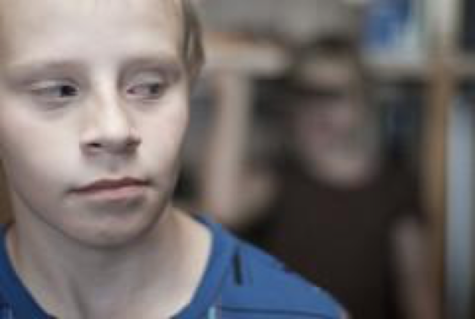Are you being watched?
October 12, 2017
Your hair stands on end. Your skin begins to crawl. You feel eyes on you… Or do you?
The “feeling” of being watched is a common trope in Hollywood horror films and shows. However, it has been studied as a scientific phenomena for a little over a century. In that time, science has revealed that the “feeling” of being watched may just be visual cues that are being subconsciously processed in the brain.
The first published study on the effect was written by Edward B. Titchener, a British Psychologist from Cornell University, and published in 1898. The conclusion of his experiments was that the feeling of being watched from behind was illusory. He found that when someone felt they were being watched, they would turn around to check. That motion attracted attention, so when they looked for someone watching, there was.
While there is no sixth sense, gaze detecting may simply be a feature of the human brain.
According to Popular Science, research has been done to identify what detects the gaze. The research involved cortically blind people which means their eyes work, but their brain doesn’t process the information. Throughout the research it was found that when people are being looked at, there is an increase of activity in the amygdala, the part of the brain responsible for emotions, survival instinct, and memory.
Tom Stafford, a lecturer at the University of Sheffield, explained in an article on BBC, that cortically blind people were also able to “… ‘guess’ where bright lights in front of them were, detect emotion, and ‘see’ movement.”
Although they are unable to consciously see, their brains are still subconsciously processing some information from their eyes. This has led scientists to conclude that eyes perceive more than just the primary focus.
This links to gaze detection because often cues for gaze detection, such as body position and eye movements, are outside of a person’s primary focus.
Ilan Shrira, a social psychologist at Lake Forest College explained in an interview with Discover Magazine that “the feeling of being watched originates in the visual system.”
Although, often the original cue will come from the peripherals, and people will be unaware they even saw the cue in the first place.
Because the brain subconsciously processes the cues, people usually feel like gaze detection is a sixth sense. However, Shrira explained that “the only conclusive demonstrations of an accurate sense of being watched come from experiments in which the subjects had visual cues to go on.”
However, in Hollywood, there in a common depiction of the feeling of being watched. Usually a character, like Ziva David in NCIS or Jason Bourne in The Bourne Ultimatum, “knows that he [or she] is being watched by someone (or someones) despite no one nearby appearing to pay any attention to them,” according to TV Tropes.
The character almost always attributes the feeling to “Spider-Sense, Telepathy, knowledge of an Ancient Conspiracy, the presence of someone in a Conspicuous Trenchcoat, or similar tropes.” Sometimes this may include going as far as breaking the fourth wall and staring directly into the camera. In doing this, pop culture depictions of being watched perpetuate the sixth sense myth in human gaze detection.
The “as seen in movies” version of gaze detection has already been proven false, but research has found more than just evidence against this Hollywood myth.

In an article on The Conversation, Harriet Dempsey-Jones, a neuroscience researcher at the University of Oxford, explained that “scientists have already identified a specialized group of neurons in the macaque [a type of primate] brain that fire specifically when a monkey is under the direct gaze of another.”
This has led scientists to believe that similar neurological connections may be present in the human brain. It makes sense that human brains would have specialized regions for gaze detection. As social animals, gaze detection is extremely important to survival. Even human physiology allows for better gaze detection.
According to Dempsey-Jones, human “eyes are exceptionally formed to catch attention and easily reveal the direction of gaze.”
Unlike other animals, human eyes have a large sclera (the white of the eyes) and small pupils and irises. This allows changes in gaze to be detected more easily than the gaze of animals like dogs who have large pupils and irises but smaller scleras.
Easier gaze detection is important for social animals because gaze can indicate many things. In an article on Psychology Today, Shrira explains that gaze can detect emotions, intentions, likes, dislikes, and what someone considers meaningful. A direct gaze can also be a way of catching someone’s attention to draw them into a conversation. The ability to detect these things allows humans to be better at socializing in all environments.
However, most people overestimate how right they are about sensing when people are watching them.
“We’re probably right less often than we think,” Shrira explained. “We may get the feeling that a specific person is watching us, but maybe it turns out they were looking at something behind us instead.”
The feeling of being stared at can also be a self fulfilling prophecy.
In an article on the Scientific American, Adam Waytz, a psychologist at Northwestern University’s Kellogg School of Management, explained that sometimes “an individual in the front of a populated room, believing him/herself to be watched, begins fidgeting, thereby attracting attention from the people in the back of the room,” so when the person turns around, there are people staring at them.
This phenomenon can also be applied to a situation where someone feels they are being watched and turns around quickly to check. The movement attracts the gaze of others around them, so when they check, there’s someone looking at them.
As well as overestimating how often they are right, certain groups of people may feel they are being watched more or less often than others.
In an article on Daily Mail, Professor Colin Clifford of the University of New South Wales Sydney explained that “people with social anxiety have a higher tendency to think they are under the stare of others.”

In contrast, “people who have autism are less able to tell whether someone is looking at them,” said Clifford. So far, there has been little research done to find out why these certain groups react differently.
Shrira has also suggested that there may be emotions that increase the feeling of being watched.
“We’re probably more sensitive to other people’s gazes when we feel more self-conscious such as feeling nervous, afraid, embarrassed, or proud. In contrast we’re probably less sensitive when we’re distracted or focusing on something intently,” he explained.
The ability to detect that someone is staring is very real, but the actual feeling of being watched is not as real as someone might think. Titchner published his study “The Feeling of Being Stared At” in which he explained that a gaze would not have any effect on the skin that would create the tingling sensation that is commonly described.
Titchener believed that the sensation came from the fixation.
Titchener described this phenomenon saying “if one thinks hard of one’s knee, or foot, e.g., one will obtain a surprisingly intensive and insistent mass of cutaneous and organic sensations of which one was previously unconscious.”
But basically, if a person thought someone was staring at their back, their fixation on their back would create a tingling feeling.
Although humans may not have a sixth sense and are unable to actually feel a gaze, Shrira says that it’s incredible that “in a barely perceptible way, [the brain tells us] that something meaningful is happening.”








